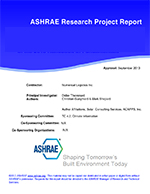Description
The objective of this project was to develop and verify an improved and extended algorithm for use in a smoke control program that simulates the flow of air in a multizone building. The algorithm requirements were that it: uses the best possible solution method chosen from a set of algorithms frequently used for solving pipe network problems; be programmed in FORTRAN; and includes models not available in ASCOS (fan and duct flow models).
Four different network analysis algorithms were considered. These were: the sequential node method, the simultaneous node method, the simultaneous loop method, and the linear theory method, which is also a loop-based simultaneous method. A description of each of the simultaneous solution techniques was developed, after which these methods were implemented in separate computer programs. Each program was based on a single existing computer program, so that similar solution techniques and the same input data would be used. That program was reviewed by an external agency to ensure it had capabilities similar to those required for smoke control analysis. The sequential method had already been implemented in another_existing program (ASCOS).
The algorithms, as implemented in these programs, were then evaluated by comparing their performance on the basis of convergence reliability, accuracy, speed, memory requirements, ease of use, and flexibility. A data set supplied by ASHRAE, which consisted of 50 different cases involving various building and smoke control system types, was used in the evaluations. ASCOS has exhibited difficulties in the past with the particular cases selected. A proprietary computer program was used to automatically generate loop data for the loop-based methods.
Product Details
- Published:
- 1992
- Number of Pages:
- 256
- File Size:
- 1 file , 5.2 MB
- Product Code(s):
- D-RP-618




